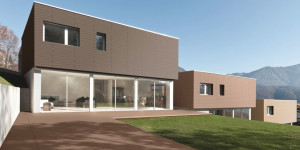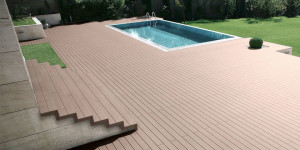Composite lumber is a material that is a mixture of wood fiber, plastic (high-density polyethylene (HDPE), polystyrene (PS) and PET plastic as well as mixed plastics) and some type of binding agent. These ingredients are put together to form a material that is denser, stronger, and heavier than wood alone, a wood-plastic composite. Due to environmental and durability concerns, composite decking (a mixture of two materials, typically wood pulp and recycled material such as polypropylene or virgin plastic) have appeared on the market. Proponents of composite decking have touted this as a much needed development as this helps to curb logging of trees for new decks. However composite decking has been found to contain harmful chemicals, cannot be refurbished, and despite claims from decking companies, some composite decking still attracts mold. However newer more modern composites feature a cap or shell that prevents mold and staining.
Working with composite lumber is similar to working with wood. However, composite lumber has the added benefit of being less likely to split or delaminate. Some composite lumber is also engineered to be lighter weight for easier handling. Composite lumber is also more stain, scratch, and mold resistant, and is therefore supposed to have a longer life than wood lumber.
Composite lumber comes from the manufacturer as a finished product. There is no need to stain, sand, or paint the material. Composite materials usually cost more than lumber, but their long life and low-maintenance requirements could make them more economical in the long run. Many composites are often made partially out of recycled plastics and waste wood, such as Trex Decking, which makes them an environmentally friendly, efficient use of resources
Composite lumber is usually more costly than normal or treated lumber. Composites may last longer, but the initial investment is likely to be higher. Many composites are formulated to be fade, scratch, and stain resistant, but no lumber is immune to the elements. Although composite lumber may resist these marring effects better than other materials, it will still show signs of wear over time. Composite lumber often has a plastic-like or synthetic appearance. Although manufacturers do mold the product with a wood grain or brush stroke pattern, some consumers simply do not like the artificial sheen.
The growth of wood-alternative products continues to fuel a debate about their environmental value when compared to wood, treated wood, metal and other alternatives. Many suggest that wood decking is made from a more sustainable ingredient and that it carries a smaller manufacturing carbon footprint. Others have claimed that the sawing of wood-alternative products during construction creates dust that will not biodegrade and that the wood-alternative deck boards, when they have outlived their useful lives, will not biodegrade in landfills.
Capped composite decking is composite decking, with a thin, approximately 1/16th inch, PVC-like veneer, or cap.This cap provides protection for the composite underneath. The cap is also formulated differently, in order to provide increased fade, stain, and scratch resistance. Capped composite decking is more expensive than both normal composite decking and wood decking because of the more involved manufacturing process in adding the second, co extruded layer to the board. Capped composites also lack the feel of real wood. Although manufacturers form the product with a realistic wood grain or brush stroke, some contractors and deck owners will not accept the artificial sheen. Capped composites, although formulated to resist fading, stains, and scratches, will show some wear over time, even if it is less than a normal composite or real wood product.


